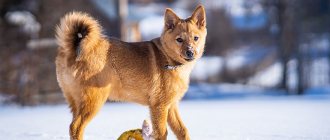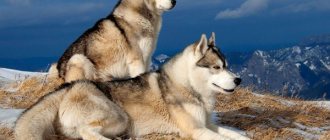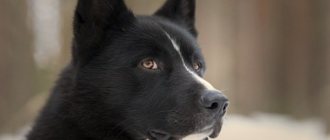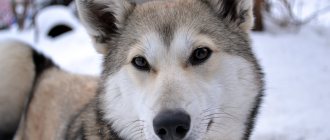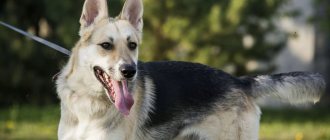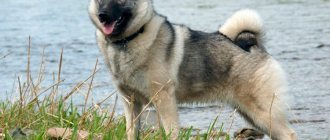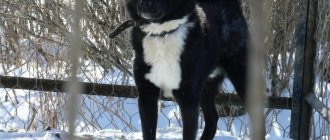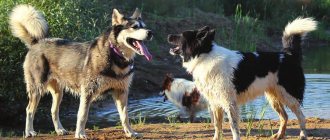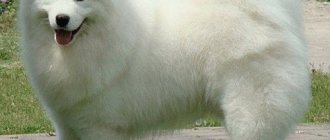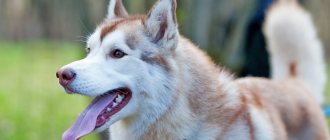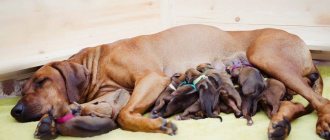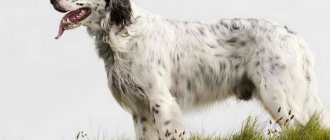Application
Red huskies are versatile dogs.
These pets enthusiastically hunt a wide variety of game - birds, ungulates, fur-bearing animals. Some individuals of the breed successfully work for bears, beavers and other animals. When hunting, the Karelian husky makes its own decisions, driving the prey directly towards the person. This makes her an indispensable partner. Modern dogs of this breed are often bred as companions. Karelian Laikas are very loyal to people, ready to accompany their owner everywhere and help him in all matters. For a Finnish Spitz to be happy, it needs to be constantly busy with work and not limit its freedom of movement.
Brief historical background on origin
The Finnish Spitz, at the suggestion of a French gentleman, was spotted in his homeland, where he was especially popular among hunters. It is impossible to say exactly how ancient it is. During the war, like many others, she could have disappeared completely. At the end of 1880, she received a new impetus for life from amateurs who managed to increase the number and continue breeding.
Laika - “Karelian” received another, official name “Finnish Spitz” and went to neighboring countries. In the Russian Federation, on the territory of Karelia and St. Petersburg, there also remain a significant number of dogs that were actively bred by their neighbors - the Finns.
By the end of the 20th century, the dog mainly spread to America and EU countries. And to this day, in their historical homeland, their number greatly predominates.
in Finland, Lapland, in the Arkhangelsk and current Leningrad regions. Laikas at that time were kept as yard dogs and were bred uncontrollably. Purposeful work with the breed began only in the 20s of the twentieth century after it was first brought to the exhibition of national economic achievements.
And as a result, the first breed standard was approved only in 1936. Active work on breeding continued in the USSR after the war, in the 40s. For stability, the Karelian-Finnish Laika began to be crossed with the Finnish Spitz. The breed was stabilized, but this led to claims from Finland, and the first time the question of unifying the names was raised in 1984.
And in 2006, an agreement was reached between the Russian Canine Federation and the Kennel Club of Finland, according to which the Karelian-Finnish Laika and the Finnish Spitz were combined into one breed - the “Finnish Spitz”. It was then that the breed standard was finally determined in the form in which it exists now.
However, now many breeders, supporters of the domestic origin of these dogs, adhere to the standard and description of the Karelian-Finnish Laika adopted during the Soviet era, and do not support their crossing with Finnish Spitz. But the International Canine Federation recognizes only the Finnish version of the appearance of these dogs. And since Finland became a member of this organization before Russia, it determines the rules for the selection of Finnish Spitz.
Finnish Spitz
History and origin of the breed 1675 - First mentioned by the French traveler Pierre la Martignard in 1675. He wrote about “dark red” dogs discovered in Finland.
1880 - Finnish hunters Hugo Roos and Hugo Sandberg purchased specimens of bright red huskies and set about reviving the breed.
1892 - The breed was recognized by the Finnish Kennel Club.
1895 - First mention in Russia in the “Album of Northern Laika Dogs” by Prince A. A. Shirinsky-Shikhmatov. Mention is made of dogs of red and gray-red color, distinguished by a pronounced hunting instinct and intelligence.
1897 - In Finland, the standard for the Finnish Spitz was revised, the dog's format became closer to square.
1927 - Sir Edward Chichester introduced Finnish Spitz dogs to Great Britain.
1935 - The Finnish Laika was registered in the English Kennel Club under the name Finnish Spitz.
1950 - The Finnish Spitz was introduced to the United States.
1952 - J. W. H. Skoltens-Keyser introduced the Finnish Spitz to the Netherlands.
Subsequently, the Finnish Spitz was declared the national breed of Finland. In Finland, the Finnish Spitz is most widespread and popular.
Development of the breed in Russia In Russia, the Finnish Spitz was dubbed the “Karelian-Finnish Laika”, after the name of the Karelo-Finnish SSR, on the territory of which these dogs were most common. As an independent breed, the Karelian-Finnish Laika was formed by the end of the 60s.
Leningrad and Moscow became the main breeding centers. The founders of the Leningrad center of the breed were dogs of unknown origin: Mink A.P. Solovyova, Damka P.V. Bolshakova, Astra E.I. Ivanova, Jim N.A. Malyarovsky, Buyan-M.T. Kozlova and Marik V. Martsinkevich. Almost all of them had good working qualities and a typical Finnish Spitz appearance.
By the end of the 70s, there were already more than 350 dogs in Russia, mainly in the Moscow breeding center and the Kirov region, where the VNIIOZ kennel was engaged in breeding.
Selection and breeding work was carried out, among other things, using Finnish Spitz imported from Finland as producers. Thus, gradually the dogs became of the same type.
In 2006, an agreement was signed between the RKF and the Finnish Kennel Club on the recognition of Russian livestock in the FCI system.
Currently, the number of these dogs is high in Moscow, the Republic of Karelia, the Republic of Udmurtia, and the Leningrad region. At the same time, the Finnish Spitz breed spread throughout all regions of Russia. Karel breeders began to unite into large communities; in 2011, the All-Russian Cynological Public Organization Finnish Spitz Breed Club “SUOMEN” was formed, which united owners and breeders from all regions of Russia.
What is the name of the Finnish Spitz breed in different countries? In Russia - Karelian-Finnish Laika, Karelian, Finnish Spitz In Finland - Suomenpystykorva In Great Britain - Finnish Spitz In Sweden - Finsk Spets In Norway - Finnish low-low
Specialization of dogs of the Finnish Spitz breed All-rounder dog, successfully hunts the following types of game and animals: upland game (grouse, grouse, woodcock, hazel grouse, pheasant), ungulates (roe deer, elk, deer, saiga), furs (squirrel, marten, mink , sable, weasel, ferret, ermine), as well as bear, badger, raccoon, beaver, etc.
| A country | Finland | |
| Time | late 19th century | |
| Height | males | 47 ± 3 cm |
| bitches | 42 ± 3 cm |
| 12-13 kg | |
| bitches | 7-10 kg |
Taken from Wikipedia
Socialization
Finnish Spitz are quite difficult to socialize. This feature of the breed is associated with the innate independence of animals. Karelian husky puppies require appropriate upbringing from childhood.
If a dog was bred for hunting, it is taken to the forest at 3-4 months. An adult pet will be frightened by unfamiliar sounds - he will behave timidly and insecurely.
Favorite companions are accustomed to life in the city - they are walked on noisy streets, introduced to new people and other dogs. Initial training helps to establish contact with the pet, which facilitates its further education.
Finnish Spitz are not very fond of other dogs. At best, the animal will not pay attention to the animal, at worst, it will start a fight. But if pets grow up in the same territory since childhood, they become excellent friends. The same situation is observed in relation to other pets, including cats.
Cheerful and cheerful Finnish Spitz get along with children, but the latter should not cross the boundaries of what is permitted. An independent pet should not be pulled by the ears and tail, or squeezed if it does not want to. The child should be told in advance about the rules of behavior with the animal.
Description of appearance standard
The Finnish Spitz is an interesting and compact dog with a square body. The tail is cutely curled into a donut, which gives it a special playfulness.
Karelo is a Finnish beauty Laika and her description clearly gives external signs by which one can distinguish the breed.
- Weight and height for males: 45 – 50 cm, weight 12 – 15 kg;
- Females: 30 – 45 cm, weighing 10 – 12 kg;
We suggest you familiarize yourself with: Large Spitz Care and maintenance
Bitches are much smaller and lighter, and are easy to distinguish by gender. Outwardly it looks like a Spitz and a little like a fox, the similarity is especially visible on the face.
- Head: medium size, wedge-shaped, forehead – wide, stop not clearly defined. Resembles the muzzle of a fox, but wider and less pointed.
- Muzzle: medium long, pointed. Dry type, pronounced cheekbones.
- Eyes: oval, with slight slanting at the corners. The look is direct, interested. No dampness on the eyelids, full coloring. Color – brown, different saturation.
- Nose: not large, mobile, wide nostrils, color – black, fully colored. May be slightly brownish with certain coat colors.
- Jaw: strong, quite strong. The bite is scissor-shaped, the lips fit tightly, completely hiding the teeth. Color – dark. White teeth, large fangs.
- Ears: hard cartilage, ears stand up, not large, look up, triangular in shape.
- Body: square, neck rather long, medium wide. With good muscles. The back is without sag, quite wide and strong. The croup is slightly sloping, the loin is short. There are well-developed muscles throughout the body, mostly of the lean type. The stomach is tucked. There are no skin folds.
- Chest: not clearly defined, up to the level of the elbow joint, the transition is obvious.
- Paws, tail: limbs straight, stand parallel, developed muscles, hip wide, strong. The paws are collected in a dense ball, the toes are rounded with strong claws. The tail is long, curled into a ring, and thrown over the back.
Coat and colors
The Karelian Laika is the owner of a luxurious fur coat. The coat is abundant, straight, fluffy. Pleasant to the touch, quite soft, good undercoat.
- Color: red, of varying saturation, there may be spots on the chest of a light (white) color, acceptable, but not encouraged. Preference is given to rich fiery red, red and brown color.
The Laika should not have feathers, but many owners simply trim the fur in these places, this happens often. Outwardly, the brightest color - brick or even copper - red looks beautiful; it may have an admixture of dark hair, but without spots. Reminds me of the color of a fox.
Description of the Finnish Laika
Other names for the Finnish Laika are Karelian-Finnish Laika, Karelian, Finnish Spitz, Suomenpystykorva. According to the FCI classification, it belongs to the 5th group “Spitz and primitive types of dogs”, 2nd section “Northern hunting huskies”, standard dated 08/09/1999 No. 49. When assessing an individual, working tests are mandatory only in Scandinavian countries (Sweden, Norway, Finland).
Appearance of the Karelian-Finnish Laika
The general impression of the Finnish Spitz is that of a medium-sized dog, almost square in format, with a proud posture.
According to the standard, individuals must meet the following requirements:
- Important proportions: The length of the body is equal to the height at the withers.
- The depth of the chest is slightly less than half the height at the withers.
- The ratio between muzzle and skull is approximately 3:4.
- The length of the skull is slightly greater than the width; the width of the skull is equal to its depth.
- ideal height for males is 47 cm;
- males - 12–13 kg;
The running movements of the Finnish hound are wide and sweeping with a strong push of the hind legs
Personality of the Finnish Spitz
By nature, the Finnish Spitz is very lively and energetic, even restless. In dangerous situations, brave but cautious. Despite the attachment to the owner and the desire to please him, the dog never loses its self-esteem. For the same reason, the Finnish Spitz will never “suck up” to the owner, begging for affection or a tasty morsel. This is a harsh northern breed, loyal, but not very affectionate. The love and care of other family members is always reciprocated, but she can never be a nanny for children.
The psyche is fully formed by approximately 4 years. It is at this age that the dog begins to show independence. Therefore, it is important not to miss the moment to remind who is boss in the house.
The Finnish husky will be able to get along with other dogs, especially if they are engaged in general work, but all other domestic animals will always remain prey; you cannot count on tenderness towards cats and hamsters. These qualities are transmitted at the genetic level, so you should not think that your pet will be different. The only thing you can hope for is that he will not chase your cat in your presence.
Disadvantages and disqualifying characteristics of the breed
Any deviations from the breed standard are considered faults, the severity of which is assessed depending on the degree of impact on the appearance and health of the dog.
Defects include:
- heavy head;
- rough muzzle;
- underdeveloped lower jaw;
- ears directed forward at an acute angle, hung to the sides or with ends brought together, curved back or with long hair on the inside;
- loose or too tightly curled tail;
- long, soft, too short or tight coat on the body;
- sharp boundaries of color in the coat.
The following are considered disqualifying defects:
- aggressive behavior towards people;
- soft ends of ears;
- flesh-colored nose;
- undershot or overshot;
- eyes are bright yellow or blue;
- tail with a break;
- large white markings on chest and/or white socks;
White socks on the paws are a disqualifying feature of the Finnish husky’s appearance.
- the presence of a color in the color that is sharply different from the main one;
- wavy or curly hair on the body.
Video: hunting dog - Karelian-Finnish Laika
How to choose a puppy
- hunting;
- participation in exhibitions;
- as a companion.
In the first case, it is recommended to purchase puppies born from working Finnish Spitz dogs. Show-class animals, although they have a chic exterior, may be unsuitable for performing their direct duties.
Karelian females are more docile and calm, so they cope better with the role of companions than males. They become more attached to people and do not try to take a leading position in the family.
- shiny wool without foreign odor;
- lively look;
- clean eyes and ears;
- wet and cold nose.
You need to get to know the parents - evaluate their appearance and temperament. It is better not to buy puppies from animals with obvious physical or mental abnormalities. Most likely, defects will be inherited.
Puppies must have documents - RKF metrics with parents' numbers.
Breed Features
Let's consider the exterior and temperament of the smallest representative of hunting huskies, according to established breed standards, and also analyze the existing basics of training.
Appearance: height, weight, color
According to the standard registered in 1997, the husky from the province of Norrbotten has:
- Raised and mobile, slightly larger than average sized ears are triangular in shape with a hard surface and rounded tips.
- Wedge-shaped head without skin folds, with a strong skull and sharp muzzle.
- A long neck, proportional to the body and with pronounced muscles. The withers are pronounced, the back is short and strong.
- Medium-sized almond-shaped eyes with black irises.
- Straight nose with a dark nose.
- Thin and dry lips tightly covering the jaw with a scissor bite.
- Square body with a compact body, wide loin and muscular croup. The shoulder blades are pressed tightly to the sternum.
- Light and graceful gait, ensured by straight, parallel paws with a pronounced hock joint and well-developed muscles.
- Tail curled into a ring. The tip reaches mid-thigh.
- Thick and straight coat with a soft, rich undercoat and guard hair of medium length.
The standard allows any colors, but white is considered the winner. The color is not uniform and contains large and clear spots of the following colors:
a. agouti; b. red; c. fawn; d. deer; e. yellow; f. black.
Please note that the length of the coat is uneven. The shortest length of hair is recorded on the back of the nose, between the ears, the front surface of the paws and on the entire ear, and the longest on the tail, hips (“pants”) and neck (“collar”).
The maximum height for Norrbottens reaches 42cm, and for dogs – 45cm. The weight of the animal varies from 12 to 15 kg.
Character of Karelian-Finnish huskies
The Finnish husky is a bright animal not only in color. The dog is a born hunter, passionate, brave, fast and very smart. She may be overly emotional, but she is alert and attentive in her work.
Sometimes he may show a hint of stubbornness, but in general there are no problems. She loves her family and tries very hard to protect. Great with children. Knows when to hide. A good-natured, patient and polite friend.
Does not tolerate shouting and rudeness, prefers to avoid conflict. Wary of strangers, but not hostile. Attentive and observant. Like many varnishes, it often howls, even at night.
Mating
Only functionally and clinically healthy pets that do not have obvious deviations from the breed standard are allowed for breeding. The optimal time for mating is after the onset of the third heat. Finnish Spitz males are ready for breeding at the age of 18-20 months.
Dogs are wormed and vaccinated in advance. First, the pets are introduced on neutral territory, then the bitch is brought to the male. Animals are usually mated freely, but some males may snap or bite. In this case, an experienced instructor should intervene.
Karelian pregnancy lasts 62-65 days. However, the period may decrease or increase slightly - it all depends on the size of the litter. In most cases, huskies give birth on their own. But the owner must control the process in order to help the animal if necessary. Most often, 3-4 puppies are born in one litter.
We invite you to familiarize yourself with: Freestall housing of cows: pros and cons, feeding and milking technology
Training and education
Finnish Laika - requires early socialization, starting from 2 - 2.5 months of age, as soon as it moves to a new owner. It includes:
- Accustoming to your nickname;
- Wearing a leash and collar;
- Loud sounds and strangers;
- Busy streets, cars.
After he gets used to it, start learning the first, not complex commands:
- Sit;
- Lie;
- It is forbidden;
- Place.
Use a tasty treat and a kind word as encouragement. There should be no punishment or shouting during the process. To teach hunting craft from 4-5 months, it is better to start with a special training program with a specialist.
The process begins with smells, the dog receives various animal skins and feathers to try. Learn to follow this scent. Baiting is a more complex process; it begins with small animals, gradually moving to larger ones. It is better not to use a husky for hunting very large animals - bears, wild boars. Their compact size will not allow them to work competently; they will lose in strength and may die.
Most Laikas are very smart, intelligent and trainable dogs, but not all. There are individuals that are very difficult to work with. The owner must be very assertive; the dog immediately notices weakness. Sometimes you have to be strict, but all punishments must be justified. With a puppy, commands are practiced in a playful way, little by little, without getting boring. Only by 10 months does enlightenment usually appear, and no matter how much one would like it, one should not use physical force on a husky.
When working with the Karelian-Finnish Laika you will have to stock up on considerable patience. Only by the age of 2 years does a dog begin to look like a person’s friend. In the sense that he understands and follows commands, but not always, due to his excitability. Laikas are very stubborn and capricious; they cannot be corrected, but they can be educated.
Hunters advise not to train the dog on everyone, but only on the animal or bird on which the dog will most often work. A good working husky definitely needs practice; the more of it, the more useful skills the red-haired assistant acquires and the more effective the hunt with him will be. From an early age, the dog is accustomed to the forest and gunshots. Of course, heredity plays a huge role.
How much do Karelian-Finnish Laika puppies cost?
It is recommended to buy a Karelian-Finnish husky puppy no earlier than he is 3 months old. Then you need to decide on the purpose of purchasing a puppy: for fun, you can find a dog from an advertisement on the Internet, but for hunting it is better to take a puppy from a kennel. The price of a Finnish Spitz depends on the gender, place of purchase, and class of the dog, and ranges from 25 to 80 thousand rubles. In Moscow and St. Petersburg, the price may be lower, since there is higher competition among official breeders and nurseries.
- pet class - about 20 thousand rubles;
- breed class – 30-40 thousand rubles;
- show class - from 50 thousand rubles.
A Finnish Spitz puppy born from top-notch hunters will cost more. The price of trained and trained animals reaches 100 thousand rubles.
Private individuals sell pets without documents for more modest amounts - 5-10 thousand rubles. However, in this case there are no guarantees of the breed and health of the animals.
Purpose of the breed and hunting
The Finnish Laika is a commercial hunter by purpose. They are generalists, designed to catch smaller prey. With the help of a keen sense of smell, they find the trail and track it, after which they bring it under fire. The shot prey is brought strictly to the owner; they can climb into large holes.
- They are passionate, smart, stubborn and result-oriented. They work in unfavorable weather conditions, in forest and swampy areas.
Perfectly tailored for poultry. The process begins early in the morning, when the sun has not yet come out. At this moment, the bird comes out to feed, the dog quickly identifies it and brings it under the shot, having previously informed the owner that the trail has been found.
It perfectly picks up a trail in the snow, identifies the marten and drives it up a tree, which then has to escape pursuit along the tops. Large wild animals are usually not approached, they are only driven into a shelter, where they continue to be held, waiting for a person.
We suggest you read: How long does pregnancy last in cats, Scottish Folds?
Spitz and primitive breeds
| +7 (495) 798-8858 | |
- Home News
- Photo gallery
- Vacancies
- affiliate program
- Blog
- Forum
- Contact Information
Services
Spitz and primitive type breeds.
These are ancient breeds that were formed without the participation of breeders. They were shaped by nature itself and territorial need. As a result of a rather strict selection, universal dogs appeared: hunting, sledding and guard dogs.
Dogs adapt well to natural conditions, are hardy and change little.
Primitive breeds retain the image of their ancestors throughout the entire period of their existence. It is very important for the owners of these breeds to understand their responsibility. After all, their pets are strikingly different from the selection specimens.
Northern sled dogs. Direct descendants of the most ancient primitive dogs. Wolves were involved in the appearance of some of them. In these breeds, the presence of the ancestor is still clearly expressed in external and behavioral signs.
Sled dogs existed as a vital necessity for polar explorers. Many geographical discoveries of the north were made with the use of sled dogs. The discovery of the poles was carried out using dog sleds. They can travel quite a long distance in a day. Their performance characteristics have evolved over hundreds of years. These breeds can be equated to the main wonders of the world.
The Spitz is used as a guard, sled dog, and also as a herding dog. Used as a hunting, sled and herding dog.
Nordic sled dogs:
Alaskan Malamute. An independent and devoted creature. Greenland sled dog. The most reliable form of transport. Samoyed. A loving companion. Siberian Husky. Hunter, transport and pet.
Northern hunting dogs:
East Siberian Laika. Sled and hunting dog. Emthund. Brave and confident. West Siberian Laika. Active, strong and resilient. Karelian Bear Dog. Brave, stubborn and very beautiful. Norrbotten Spitz. Friend, companion and guard. Norwegian Lundehund. Watchman and security guard. Norwegian Elghound (gray, black). Elk breed, strong and powerful. Russian-European Laika. A very loyal and gentle dog. Finnish Spitz. Watchman and security guard.
Northern guard and herding dogs:
Visigothic Spitz. Security guard and family man. Icelandic dog. Endurance and vitality. Lapinporokoira. Watchman, shepherd and companion. Norwegian Buhund. Guide, bloodhound, companion. Suomenlapinkoyra (Finnish Lapphund). Security guard, companion and service dog. Swedish Lapphund. Watchman, nanny, pet.
European Spitz:
Italian Volpino. Watchman and protector. German Spitz (dwarf, small, medium, large, wolf). Activity and energy.
Asian Spitz and related breeds:
Akita. A dog is anti-stress. Eurasier. Companion and devoted friend. Kai. Hunter and partner. Kishu (Kishu). Wisdom and sophistication. Korean dog Jindo. Hunter, watchman, companion. Chow chow (short-haired, long-haired). Beauty and eternal battle. Shiba (Shiba). Brave and independent. Shikoku (Shikoku). A hunter with character. Hokkaido. Universal dog. Japanese Spitz. Dog companion.
Primitive type breeds:
Basenji. Manners, curiosity, stubbornness. Mexican hairless dog. Loyal and balanced. Peruvian hairless dog. Grace and love. Pharaoh's Hound. Lord. Canaan dog. Watchman, security guard, friend.
Primitive type - hunting:
Podenco Canario. Courage and bravery. Podengo Portugues (small, medium, large). Energy, fun and dedication. Cirneco dell'Etna. Sports and energy.
Hunting with a ridge on the back - primitive type:
Thai Ridgeback. Talking dog.
Helpful information:
- "Animal Hotel"
- "Overexposure"
- "Professional dog training school"
- "Forum and consultations"
- "Video trainings"
- "Vet"
- "Walk"
- "Dog Nanny"
Add a comment Cancel reply
What to feed the Karelian-Finnish Laika?
The best option for feeding the Karelian-Finnish husky is considered to be natural food. The basis of the diet of adult dogs is cut into pieces fresh raw meat or offal; preference should be given to beef, lamb and occasionally poultry. The diet should include hypoallergenic cereals (millet, rice, buckwheat), whole grain bread, seasonal fruits and vegetables, herbs, and dairy products.
A dog, especially one living in the city, needs to be given vitamin and mineral supplements. In addition, there should always be access to fresh drinking water. Karelian-Finnish husky puppies feed on mother's milk for up to 1.5-2 months, then you can gradually reduce the number of feedings and transfer the babies to full-fledged adult food. 3-month-old puppies usually eat 5-6 times a day, 6-month-olds - 4 times a day, and 9-10-month-olds - no more than three times.
You need to pay close attention to the diet of pregnant and lactating Finnish huskies. The dog’s diet during this period should be very nutritious - portions are increased, about 500 ml of low-fat milk is offered daily, vitamin and mineral supplements are necessarily introduced, and in case of calcium deficiency - pure chalk.
Karelo-Finnish Laika requires competent and sufficient nutrition, appropriate for age and workload. The easiest way is to feed with industrial feed, which contains everything you need and does not require preparation.
Natural food consists of the following acceptable products:
- Sea fish;
- Not fatty meat;
- By-products;
- Vegetables/fruits/greens;
- Vegetable oils;
- Eggs;
- Porridge: buckwheat, rice and oatmeal;
- Low fat dairy products.
- Vegetables should be cheeses: finely chopped or pureed. Meat – raw, offal – boiled.
It is not recommended to combine feeding dry food and natural food. Natural, requires an additional complex of vitamin and mineral supplements, bone meal.
Adults eat 2 times a day, after a walk, it is important not to overfeed. Puppies from 4 – 6 times a day up to 3 months, 4 times up to 6 months, 3 times up to 12 months.
It is forbidden to feed:
- Human food;
- Season food with spices and salt;
- Tubular bones;
- Sweets and chocolate;
- River fish;
- Grapes and plums;
- Citrus;
- Bakery;
- Potato;
- Pasta.
- The quality of life and its duration depend on proper nutrition.
Care and maintenance
Considering the origin of the animal, the optimal place to keep it is the northern countries. The modern Finnish Spitz gets along in any area, both in private houses and apartments. But to make your pet comfortable, you must adhere to the following care recommendations:
- The Finnish Spitz does not tolerate heat, so the room should be cool in summer. The structural features of his coat, like those of other northern dogs, can protect him from the most severe frost, but it is difficult for him to cope with the heat.
- Grooming is the most common. It is enough to bathe your pet 2-3 times a year. Once a week it is recommended to comb the coat, paying special attention to areas where it is thick - on the chest, tail. If you wish, you can visit grooming salons, but home care will also satisfy your dog's needs. When seasonal shedding begins, your pet needs to be brushed more often, preferably daily.
- Care for claws, ears, eyes, teeth is carried out as needed. Seeing that the claws are too long to trim, wax has collected in the ears, wipe them with a special solution.
It is recommended to visit a veterinarian at least twice a year. If proper care is lacking, which affects the pet’s health, he will immediately identify the problem and give recommendations.
Feeding
A puppy eats milk for up to 2 months; it is allowed to introduce other food into the diet at three weeks of age. It is recommended to have the following products in your diet at all times:
- lean types of meat;
- cottage cheese;
- vegetables fruits;
- any cereals;
- rye bread, crackers from it.
Strictly prohibited:
- raw bones, cooked meat;
- flour;
- fatty dairy products;
- sweets.
Some people decide to feed their pet ready-made dry food. It is necessary to choose only high-quality ones that contain all the necessary microelements and vitamins (premium or super-premium class).
Health and life expectancy
Karelo-Finnish huskies are distinguished by good health. The breed is considered genetically good. Only a slight tendency to dermatological diseases is noted; cryptorchidism and absence of premolars are sometimes encountered.
Most often, people turn to the veterinarian about injuries and wounds received while hunting. From puppyhood, dogs are required to be vaccinated according to generally accepted schemes. Regularly drive away internal and external parasites. Life expectancy is usually 13-15 years.
The Karelo dog - Finnish husky is a fairly healthy pet, with good strong immunity. There is a predisposition to inherited diseases:
- Dysplasia of large joints;
- Diseases of the visual organs - in adulthood;
- Endocrine changes, more common in bitches after childbirth;
- Diseases of the nervous system;
- Problems with the gastrointestinal tract;
- Allergy.
Health of the Finnish Husky
The lifespan of the Finnish Laika is 12–14 years. The breed is indigenous, and therefore its health is quite good.
But, as practice shows, modern representatives may be susceptible to certain diseases:
- dysplasia of the hip and elbow joints - incorrect positioning of the joint, which leads to severe lameness; a tendency to the disease is detected in puppies using a special test;
- dislocated paws - a common problem in Finnish Spitz dogs, which is provoked by their excessive activity; if you notice lameness in your pet, you should immediately contact a veterinarian;
- epilepsy is a chronic lesion of the nervous system, manifested by convulsions and impaired consciousness, the problem is corrected with medication, as a result of which the pet can lead an almost normal life.
Pros and cons of the CFL
Karelo Finnish Laika or Finnish Spitz is a wonderful animal for living with a person. They are perfect for family life and singles.
Pros:
- Small size;
- Easy care;
- Cheerful and flexible character;
- Excellent working qualities;
- Good nature;
- Mind.
Minuses:
- An active breed that requires constant exercise;
- Increased excitability and emotionality;
- They can howl and bark frequently;
- Classes must be held regularly.
In general, it is a wonderful pet, attached to a person, requiring affection and care.
Origin story
The Finnish Spitz or Karelian-Finnish Laika, as it is called in Russia, has an interesting origin story. Its ancestors were distributed in the territory of modern Finland and Karelia. Nobody considered them as decorative pets; the Suomi people used them mainly for hunting and also for protecting property. Usually there were several pets in a family, some went with the owner, and some at home to protect the family.
The breed has different names in different countries: Karelian-Finnish Spitz, Finnish Laika, Low-Lo, Suomenpustyukorva, others.
Pierre Martin became the first person to inform the public around the world about the customs and way of life of the inhabitants of the North. He published a book and wrote other works detailing his journey to that area. A significant part of all the stories was Pierre's admiration for the Finnish husky. Dog breeders around the world have become interested in the previously unknown breed.
In the 19th century, due to thoughtless crossing of representatives of the breed, there was a threat of its extinction, because there were almost no purebred Finnish Laikas left. In the mid-20th century, breeders' interest in reviving the first breed was awakened again. Since then, the breed standard has changed several times, but the changes have been minor. In the second half, the official recognition of the improved Finnish Spitz by international kennel clubs began sharply, and the breed was also recognized as a symbol of Finland.
